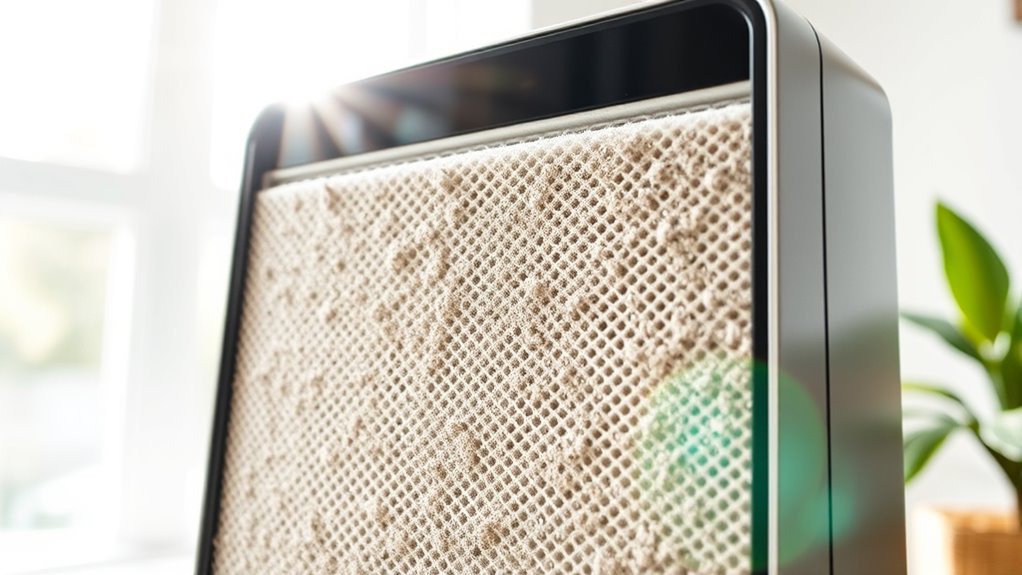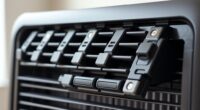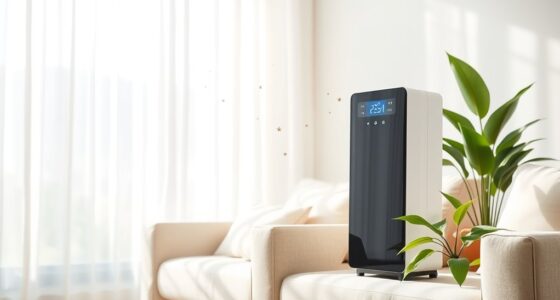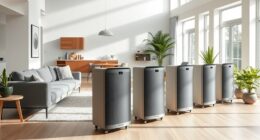Pre-filters help extend your air purifier’s lifespan by catching larger particles like dust, pet hair, and pollen before they reach the more delicate internal filters. This prevents clogging and reduces strain on the main filters, keeping your device running efficiently for longer. Regularly maintaining and replacing pre-filters not only protects your investment but also improves overall air quality. To discover more about maximizing your air purifier’s performance, continue exploring the benefits of proper filter care.
Key Takeaways
- Pre-filters trap larger particles, preventing clogging of main filters and reducing wear and tear.
- Regular maintenance of pre-filters ensures optimal airflow and prevents motor strain.
- Clean pre-filters improve energy efficiency by reducing unnecessary effort on the device.
- Protecting high-efficiency filters from debris extends their lifespan and reduces replacement costs.
- Proper pre-filter care maintains consistent air quality and prolongs the overall lifespan of the air purifier.

Pre-filters are vital components of air purifiers that help improve their overall efficiency. They act as the first line of defense, capturing larger particles like dust, pet hair, and pollen before they reach the main filters. Proper filter maintenance of these pre-filters is essential because it guarantees your air purifier continues to perform at its best. When you regularly check and replace or clean your pre-filter, you prevent clogging that can force your device to work harder, which in turn boosts energy efficiency. A clean pre-filter allows the air purifier to operate smoothly, reducing energy consumption and extending its lifespan.
Regularly check and clean pre-filters to boost efficiency and prolong your air purifier’s lifespan.
Focusing on filter maintenance isn’t just about keeping the purifier running efficiently; it also helps protect the more delicate, high-efficiency filters inside. If large particles aren’t captured early by the pre-filter, they can clog or damage the main filters more quickly, leading to costly replacements and decreased effectiveness. Regularly inspecting your pre-filter and replacing it when needed keeps the overall system functioning well. This proactive approach also means your air purifier doesn’t have to work as hard to clean the air, saving you money on electricity bills over time.
Energy efficiency is a key benefit of maintaining your pre-filters properly. When pre-filters are dirty or clogged, the air purifier’s motor has to exert more effort to draw air through the filtration system. This extra strain increases energy consumption and can cause the device to wear out faster. By keeping the pre-filter clean, you help your air purifier operate at its best capacity, reducing unnecessary energy use and supporting eco-friendly living. Additionally, a well-maintained pre-filter reduces the load on the main filters, which often are more expensive and require more frequent replacements. This not only saves you money but also lessens waste, making your overall air purification system more sustainable.
You should check your pre-filter regularly, especially if you live in a dusty or polluted environment. Many models have indicators that signal when it’s time for a replacement or cleaning. When you do clean or replace the pre-filter, follow the manufacturer’s instructions to guarantee proper filter maintenance. Doing so will keep your air purifier functioning efficiently, prolong its lifespan, and help maintain good indoor air quality. Remember, a small investment in regular pre-filter care yields significant benefits by preventing bigger, more costly repairs and keeping your energy bills in check. Proper filter maintenance isn’t just about longevity; it’s about making sure your air purifier works as effectively and efficiently as possible, providing you cleaner, healthier air every day.
An additional benefit is the protection of HEPA filters, which are often the main filtration component.
Frequently Asked Questions
How Often Should Pre-Filters Be Replaced for Optimal Performance?
You should replace your pre-filters every 3 to 6 months to maintain ideal performance. This replacement schedule helps extend your air purifier’s filter lifespan and keeps it working efficiently. Check your manufacturer’s recommendations, as some filters may need more frequent changes depending on usage and air quality. Regular replacement prevents buildup of dust and debris, ensuring cleaner air and prolonging the overall lifespan of your air purifier.
Can Pre-Filters Remove Harmful Gases or Chemicals From the Air?
Pre-filters mainly handle dust and large particles, so they don’t remove harmful gases or chemicals from the air. For chemical filtration and gas adsorption, you need specialized filters like activated carbon filters. These filters trap gases and chemicals effectively, improving your air quality. So, while pre-filters are essential for protecting your main filter, they don’t directly remove harmful gases or chemicals.
Are There Different Types of Pre-Filters Suitable for Specific Pollutants?
Imagine breathing cleaner air every day—different pre-filters make it possible. You can choose HEPA-compatible filters for allergens or activated carbon pre-filters for gases and odors. By selecting the right type, you guarantee your air purifier targets specific pollutants effectively. This not only enhances air quality but also extends your device’s lifespan. So, yes, various pre-filters are suited for different pollutants, making your environment healthier and your equipment last longer.
How Do Pre-Filters Impact the Energy Efficiency of Air Purifiers?
Pre-filters can reduce your air purifier’s energy consumption by catching larger particles early, which minimizes filter resistance. When filters resist airflow less, your device doesn’t have to work as hard, saving power. By maintaining a clean pre-filter, you guarantee efficient airflow and lower energy use, prolonging your purifier’s lifespan. So, choosing and changing pre-filters regularly helps you run your air purifier more efficiently, saving energy and money.
What Are Signs That a Pre-Filter Needs Cleaning or Replacement?
Think of your pre-filter as the gatekeeper of your air purifier. You’ll notice filter discoloration, like a mask turning gray, signaling it’s time to clean or replace it. Unusual odors, akin to a musty basement, also indicate buildup of dirt and debris. If you see these signs, don’t wait—clean or swap the pre-filter to maintain ideal airflow, improve efficiency, and extend your device’s lifespan.
Conclusion
By using pre-filters, you’re giving your air purifier a fighting chance to last longer and perform better. They catch larger particles upfront, preventing your main filters from clogging quickly. Think of pre-filters as the first line of defense—if you keep them in good shape, your device won’t be stretched thin. Remember, a stitch in time saves nine; maintaining your pre-filters now can save you money and hassle down the road.









